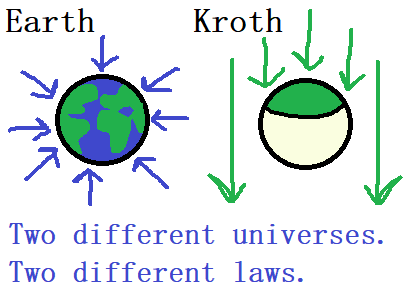Universes
What makes a universe its own?
A universe is everything according to its inhabitants. It is the totality of space and time. You cannot get between universes by car, plane, boat, time machine or spaceship. That's because what exists between universes is beyond space or time but we'll get to that later. Also you can't get to another universe by dying. That's why afterlives such as Heaven, Hell, Tartarus, Fairyland or the Western Paradise are considered sub-universes as they're intrinsically connected to a "main" sub-universe because of all the mortal souls zipping between them.
What makes them different?
Well, apart from being completely self-contained and inaccessible by all conventional means, it depends.
Keep in mind there are differences between universes that can exist that can't exist between, say, different planets. The most exotic universes are the ones where the point of divergence happened before the big bang. Let me put it this way.
If I go from Earth to Mars I don't have to worry about falling off the planet. I might be somewhat lighter, but if I ever feel like jumping I'll land on the ground no matter where I am because I can always count on gravity, as it's a natural law which applies to everything in your universe.
But say if I were to go from our universe (we'll call it Mundis because I don't like it when someone confuses a small part of an area with the rest of it, at least whoever named South Africa was honest enough to admit it takes up only a bit of the continent it's on. I'll also call this practice "name-hogging". Confound it, I've probably bored you with my tangent, time to start another sentence.) ahem

...But if I went from our Mundis to Kroth, i'd be sure to steer clear of the edge. That's because on Kroth there is a universal "up" and "down", so there's no gravity. It's just a downward pulling force. That sort of difference is the only thing that can exist between two separate universes.
If you ask me that's the only reason you'd want to go from one universe to another. If you want to see something possible by your universe's laws of physics then get yourself in a rocket or a teleporter and head there! Your universe is infinite, you have no excuse! None whatsoever! It's like ordering McDonalds from the next town over when there's one in your town when the only reason you'd have to travel for the sake of McDonalds when there's one right over there is if you're going to another country where there's different items on the menu you can't get in your own!
Aaaaaaaaaaaargh!!!
So the highest level of difference a universe can have from another one is in their physical laws and their resultant cosmologies.
That's why I prefer to group universes together with those that have similar cosmologies or similar laws of physics. Mainly because those are the biggest and most fundamental difference that can exist between two universes. Just like we you group geographical regions by which continent they're on, or subnational divisions by which nation they're in. The greatest difference between Afro-Eurasia and the Americas isn't the food or the culture, but the fact they're different continents in different spatial locations that consequentially have different geographies and climates, which go on to influence everything else.
Universe Types
Given the sheer number of variables involved there are more ways of categorizing the multiverse than you can count. The simplest way is to line them up in the order of how much of a certain value they possess. For example you could line up the multiverse by how much suffering there is, how many distinct habitable zones there are, or how many souls there are at any point in time.
The Creatrix Aealacreatranada wrote a taxonomy I'm rather fond of. You can read about it here.
I find it's an infinitely useful resource to dwell on when it comes to classifying exotic universes with their own cosmologies and laws of physics. They're a huge inspiration, and I don't use that term lightly. Perhaps the only one on Earth who covers this kind of subject matter with such depth and levity. Check it out!
But for your sake I'd go for something more earth-centric. There are Near-Earths, Half-Earths, and Exotic Universes.
Near-Earths are pretty much your own world except history played out a different way. The laws of physics and the structure of the cosmos are the same as they are in yours.
Examples: The Man in the High Castle, Seinfield, Xeelee Sequence
Half-Earths have a similar cosmology with round planets and suns and all but the laws of physics are different. In many cases they're a bit looser which allows for the existence of the supernatural. Most fantastical worlds in fiction are Half-Earths.
Examples: Earthbound, Abeir-Toril, Warhammer 40k, Spongebob Squarepants
Exotic Universes don't resemble Mundis whatsoever, whether in physics or cosmology.
Examples: The Clockwork Rocket, Pastel & Tryslmaistan, Minecraft, Tilism of Hoshruba, NagaWorld
